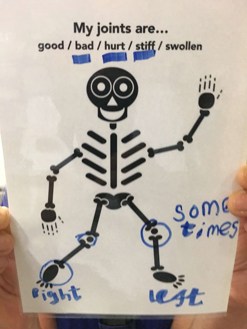Distinguishing Inflammatory from Mechanical Features
The history explores concerns and observations made by the parent / caregiver or child. Open probing questions are important. Consider red flag features.
| Inflammatory | Mechanical | Muscle | |
|---|---|---|---|
| Pain | Yes, but may not be verbally expressed, particularly in younger children (below 4 years). May manifest as change of mood or avoidance of activities. | Usually a predominant feature. | Rarely, pain in calves. |
| Relationship to activity | Movement may ease symptoms, inactivity may cause gelling. | Usually worse with and after activity. | Reduced endurance, may complain of pain in legs after activity. |
| Morning stiffness | Present. Important to ask about self-care (e.g., dressing), behaviour and activities in the mornings. Stiffness may manifest as 'gelling' after periods of rest (e.g., difficulty getting up from sitting on the floor). | Usually absent. | Absent. |
| Swelling | Yes, and usually persistent for several days to weeks, waxing and waning over months. | Usually worse with, and after activity. | Calf hypertrophy (overdeveloped calf muscles, out of proportion with rest of body). |
| Locking | Usually absent. | May be present. | Absent. |
| Giving way | Usually absent. | May be present. | May be present. |
| Worst time of day | Usually mornings. | Often after school or evening. | Mornings can be worse after activity. |
| Restriction of movement | Often present, can be profound. | May be present. | May have ankle tightness. |
| Systemic features | Fever, anorexia, weight loss may occur with inflammatory disease (and autoinflammatory or multisystem diseases in particular) but infection (including Tuberculosis) and malignancy need to be excluded. A travel history or awareness of infections in endemic areas is important. | Not present. | May be present. |


